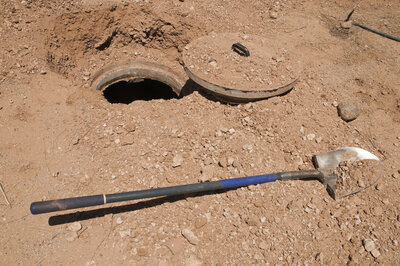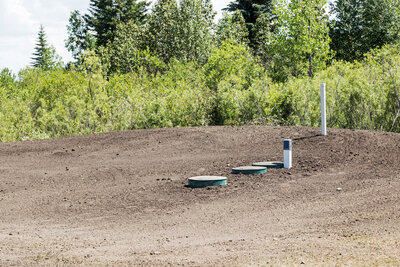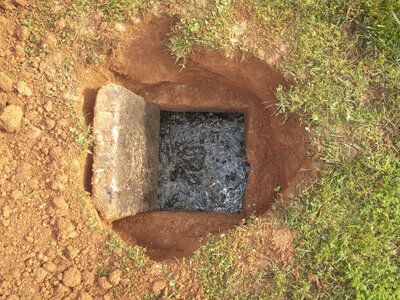Did you know you don’t have to wait for your drains to back up to tell if your septic tank is full?
You should also be able to check your septic tank yourself! With a couple of septic pumper’s tools and a little bit of DIY know-how, you should be able to tell how “full” your septic tank is.
Here’s how you can tell if your septic tank is full:
Step 1: Open Your Septic’s Access Riser
First, locate your septic tank’s access riser.
Your tank will have two to three risers. One riser provides access to the inlet T-pipe, where wastewater flows from your home to the tank.
The second riser provides access to the outlet T-pipe, where wastewater flows into your drain or leach field.
You’ll want to access the inlet riser, which should be the one closest to your home. You can always have a family member flush a toilet or run water. If you see water flowing into the tank, you’ve accessed the inlet riser.
The access riser is either on the ground or above the ground, as shown below:
In-ground access riser:

Above-ground access riser:

If you have an in-ground riser, you might need a manhole hook to remove the concrete cap. You can purchase a manhole hook from Amazon. Otherwise, you’ll need some tools to pop the lid off and unscrew it.
Aren’t sure where your risers are? Visit our blog for guidance on locating your septic tank and risers.
Step 2: Determine if Your Septic Tank is Actually Full
Did you know that a properly functioning septic tank is always full?
The waste in your septic tank contains three parts:
- Bottom Layer: The bottom layer is sludge.
- Middle Layer: The middle layer consists of wastewater, also known as sewage.
- Top Layer: The top layer is scum (human waste, fats, oils, grease, etc.)
What you want to see at the top is wastewater (a little bit of scum that's about ½” thick is okay).
What you don’t want to see is a thick scum crust. If you do see a thick scum crust, your tank is actually "full" and needs to be pumped.
Step 3: Assess What You See Floating At the Top of Your Septic Tank
Once the cap is off, look inside; what do you see?
- Do you see: water and about a half inch of sludge and scum? If this is what you see, so far, so good! You can proceed to step 4 to measure the volume of sludge at the bottom of the tank.
- Do you see: a thick crust of sludge, scum, and waste? If so, stick a garden shovel in the crust - if it’s thick and holds your shovel, your septic tank needs to be pumped.
Here's a photo of a septic tank with a thick crust of sludge, scum, and waste.
If your septic tank looks like this, you should schedule a septic pumping service:

Step 4: Measure Sludge & Scum Volumes in Your Septic Tank
Next, measure the amount of sludge at the bottom of the septic tank.
You’ll need a sludge checker tool, or you can make your own. You can purchase a sludge checker tool from Amazon.
Want to make your own sludge checker tool? We thought so! Just get a long stick and wrap some paper towels around the bottom. Stick it down to the bottom of the septic tank; you should be able to tell how much sludge is at the bottom.
Your tank should be pumped if the total volume of sludge/scum at the top and bottom is 20-30% of the volume of the tank.
For example, if your tank is 4 feet deep, your tank should be pumped if you have 8”-1’2” of scum and sludge (again at the top and bottom of your tank).
Step 5: Stick with the 2-5 Year Routine
The general rule of thumb is to pump your tank every 2-5 years.
Now, the exact time frame depends on several factors, including:
- The Size of Your Tank and Household Size. For a household of two people with a 1,000-gallon tank, pumping once every five years should be sufficient.
- Your Flushing and Drainage Practices. Do you use a lot of toilet paper and pour fat, oil, and grease down your drains? First things first - you shouldn’t! But if you do, your tank will need to be pumped more regularly.
- Your State's Recommendations. For instance, the Florida Department of Health recommends pumping once every 3-5 years. The Massachusetts Department of Environmental Protection (MassDEP) recommends pumping once every three years.
Please know the 2-5 years is just a ballpark timeframe.
Sometimes, you can go longer before having to pump your septic tank. However, going past the estimated time frame depends on how much scum and sludge are actually in your septic tank.
Septic System Pro Tips
Here are a couple of related “pro-tips” to help you maintain your septic system.
Pro Tip #1: Practice Proper Drainage Practices
Want to get the most out of your routine septic pumping services? If so, be cautious about what you flush and what you put down your drains.
Here are our home drainage tips:
- Only flush toilet paper and human waste down your toilets
- Avoid toilet paper altogether with a bidet system
- Do not pour fat, oil, or grease (FOGs) down your drains
- Don’t overuse your garbage disposal - discard large food scraps in the trash
Following these drainage tips should help you avoid needing a septic pump sooner than necessary.
Pro Tip #2: Keep Records of Your Scheduled Septic Pumpings
Remember when your septic tank was pumped.
You can either schedule your next pumping service a few years down the road. Alternatively, you can add a calendar reminder on your phone.
After having your tank professionally inspected and pumped, you'll have a much better idea of how quickly it fills up and how to prevent sewage backup in your home.
Need Expert Septic Advice? Call a Septic Company!
Hopefully, you feel more educated about your septic system and are excited to share your knowledge with your family, friends, and neighbors.
We recommend trying these DIY tips to tell if your septic tank needs to be pumped. However, if you’d like a professional’s opinion for peace of mind, call a reputable septic pumping company for an inspection.
Most septic companies charge the same fee for an inspection and pumping service. So if you call a local company for an inspection, you might as well have it pumped. From there, you can have a better gauge of when it’ll need to be pumped next.





